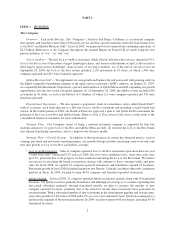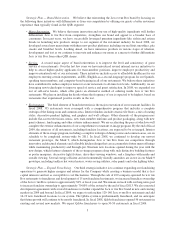Jack In The Box 2008 Annual Report Download - page 20
Download and view the complete annual report
Please find page 20 of the 2008 Jack In The Box annual report below. You can navigate through the pages in the report by either clicking on the pages listed below, or by using the keyword search tool below to find specific information within the annual report.or within the food service industry or any widespread negative publicity regarding our brands or the restaurant
industry in general could cause a decline in our sales and have a material adverse effect on our financial condition
and results of operations.
Dependence on frequent deliveries of fresh produce and groceries subjects food service businesses, such as
ours, to the risk that shortages or interruptions in supply, caused by adverse weather or other conditions, could
adversely affect the availability, quality and cost of ingredients. In addition, unfavorable trends or developments
concerning factors such as inflation, increased cost of food, labor, fuel, utilities, technology, insurance and
employee benefits (including increases in hourly wages, workers’ compensation and other insurance costs and
premiums), increases in the number and locations of competing restaurants, regional weather conditions and the
availability of qualified, experienced management and hourly employees, may also adversely affect the food
service industry in general. Because our restaurants are predominantly company-operated, we may have greater
exposure to operating cost issues than chains that are primarily franchised. Exposure to these fluctuating costs,
including anticipated increases in commodity costs, could negatively impact our margins. Changes in economic
conditions affecting our customers, such as inflation or recessionary conditions, could reduce traffic in some or all
of our restaurants or impose practical limits on pricing, either of which could negatively impact profitability and
have a material adverse effect on our financial condition and results of operations. Our continued success will
depend in part on our ability to anticipate, identify and respond to changing conditions.
Risks Associated with Development. We intend to grow by developing additional company-owned restau-
rants and through new restaurant development by franchisees. Development involves substantial risks, including the
risk of (i) the availability of financing for the Company and for franchisees at acceptable rates and terms,
(ii) development costs exceeding budgeted or contracted amounts, (iii) delays in completion of construction, (iv) the
inability to identify, or the unavailability of suitable sites on acceptable leasing or purchase terms, (v) developed
properties not achieving desired revenue or cash flow levels once opened, (vi) the unpredicted negative impact of a
new restaurant upon sales at nearby existing restaurants, (vii) competition for suitable development sites;
(viii) incurring substantial unrecoverable costs in the event a development project is abandoned prior to completion,
(ix) the inability to obtain all required governmental permits, including, in appropriate cases, liquor licenses;
(x) changes in governmental rules, regulations, and interpretations (including interpretations of the requirements of
the Americans with Disabilities Act), and (xi) general economic and business conditions.
Although we intend to manage our development to reduce such risks, we cannot assure you that present or
future development will perform in accordance with our expectations. We cannot assure you that we will complete
the development and construction of the facilities, or that any such development will be completed in a timely
manner or within budget, or that any restaurants will generate our expected returns on investment. Tight credit
markets may also slow our franchisees’ plans for growth, whether through new restaurant openings or acquisition of
company-owned restaurants. Our inability to expand in accordance with our plans or to manage our growth could
have a material adverse effect on our results of operations and financial condition.
Reliance on Certain Geographic Markets. Because approximately 60% of our restaurants are located in the
states of California and Texas, the economic conditions, state and local laws, government regulations and weather
conditions affecting those states may have a material impact upon our results.
Risks Related to Entering New Markets. Our growth strategy includes opening restaurants in markets where
we have no existing locations. We cannot assure you that we will be able to successfully expand or acquire critical
market presence for our brands in new geographical markets, as we may encounter well-established competitors
with substantially greater financial resources. We may be unable to find attractive locations, acquire name
recognition, successfully market our products and attract new customers. Competitive circumstances and consumer
characteristics in new market segments and new geographical markets may differ substantially from those in the
market segments and geographical markets in which we have substantial experience. It may also be difficult for us
to recruit and retain qualified personnel to manage restaurants. We cannot assure you that we will be able to
profitably operate new company-operated or franchised restaurants in new geographical markets. Management
decisions to curtail or cease investment in certain locations or markets may result in impairment charges.
Competition. The restaurant industry is highly competitive with respect to price, service, location, personnel,
advertising, brand identification and the type and quality of food,and there are many well-established competitors.
12
























